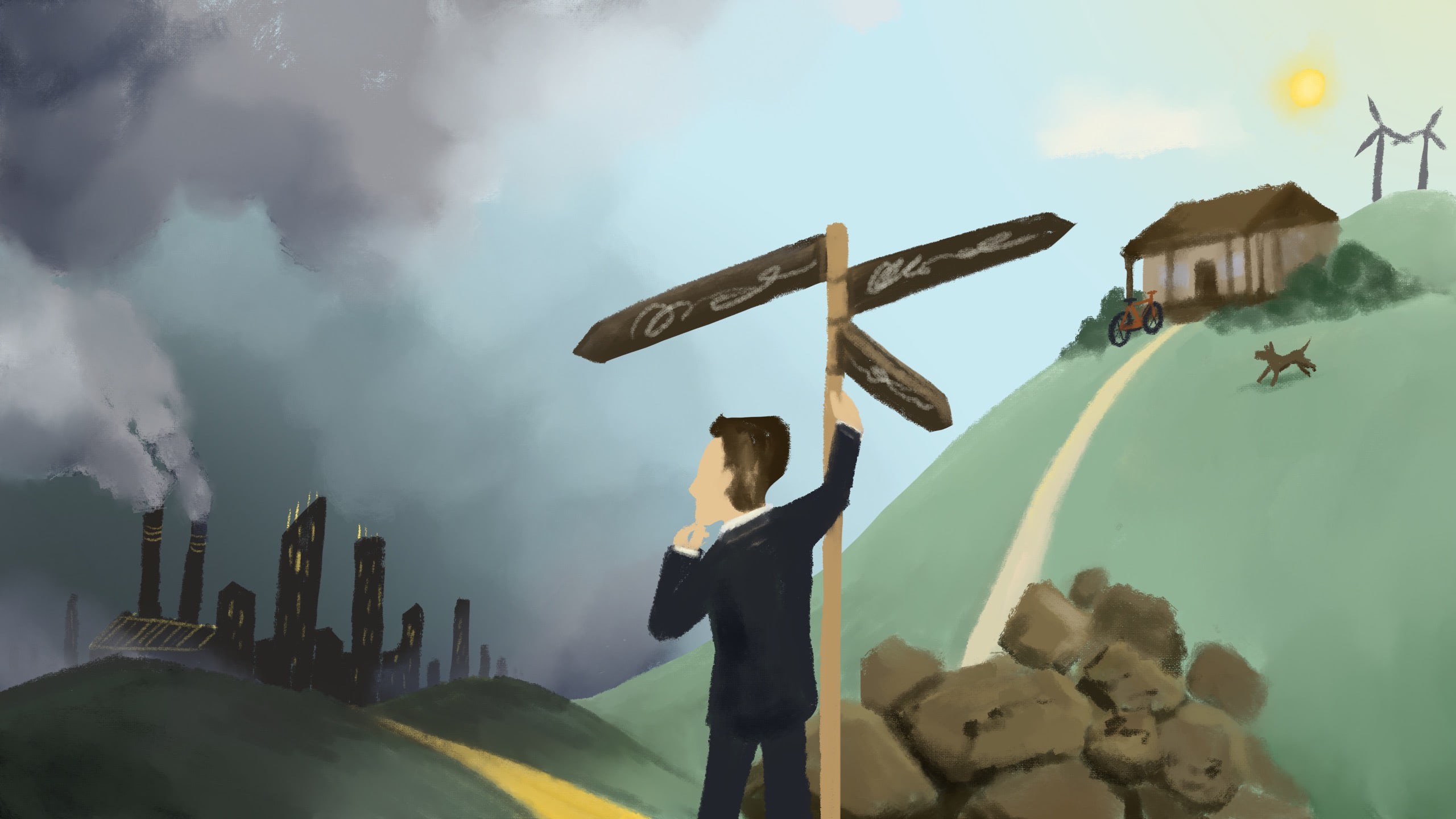Manfred Lenzen and Lorenz Keyßer

Degrowth – the promising climate change strategy no politician wants to handle?
When the person appointed by the president of the US – the world’s second largest emitter of carbon dioxide – says he is relying on unproven technologies to achieve net zero emissions by 2050 – you have to wonder what planet he is living on.
John Kerry, the US Climate Envoy, recently told a journalist that:
“You don’t have to give up a quality of life to achieve some of the things that we know we have to achieve…I am told by scientists that 50% of the reductions we have to make to get to net zero are going to come from technologies that we don’t yet have. That’s just a reality.”
Actually it’s the opposite of reality – Kerry is living in the land of technological optimism, and consumerism dominance. He is not alone. But hoping and wishing are not enough and technological gains are not going to get the world to the drastic emission cuts necessary. For the last 40 years technology has contributed about 2% year on year towards carbon emissions reduction, but that has been cancelled out by a 3.5% annual rise in economic growth – leaving the world with a 1.5% increase.
At this point in time to halve emissions by 2030 we would have to hit over 7.6% year-on-year reduction every year. To put that in context, COVID-19 has achieved 4% reduction in emissions: that is, we would have to achieve the emission impacts of two COVIDs every year to make that target.
World, we need to talk about degrowth
To be fair to John Kerry, most climate mitigation scenarios rely on controversial negative emissions schemes and unproven technological changes. There is a policy option that offers a technologically quicker and more viable way to avert climate breakdown: degrowth may sound like political death, but the failure to consider it in the fight against global warming may equate to ecological death.
Degrowth in this context means a reduction in material and energy use, likely resulting in a reduction in GDP, organised in an equitable and sustainable way that maintains societal wellbeing. Hence, degrowth should not be confused with a recession. Moreover, degrowth primarily focusses on wealthy countries in the global North, where we know that additional growth is not necessary for delivering strong social outcomes.
The danger within a post-COVID recovery
With countries around the world restarting economic growth in the wake of the COVID-19 pandemic, global energy demand as well as carbon emissions are projected to rise almost back to their previous levels. The climate crisis, and the broader ecological crisis, still remains an existential threat, especially to the most affected, but least responsible people for many of whom it already has arrived.
Here’s the problem: all of the established climate mitigation scenarios start from the assumption that countries should continue to pursue GDP growth, regardless of how rich they are. Studies show that continued growth in products and services is connected to increasing material and energy use.
In order to reconcile continued growth with the Paris climate targets, existing scenarios rely on controversial amounts of carbon removal from the atmosphere, as well as unprecedented rates of renewable energy expansion, and energy efficient gains to absolutely decouple GDP from energy and resource use. This approach faces significant obstacles.
The downsides of techno-optimism
Negative emission technologies are unproven to work at scale. They are also costly and need immense amounts of land, water and fertiliser where they rely on biomass, putting additional pressure on biodiversity and food security. In the case of direct air capture technologies without biomass, they rely on high energy and water usage. Efficiency improvements, meanwhile, are unlikely to deliver the needed absolute reductions of energy and resource use given systemic, economy-wide rebound effects. Greater energy efficiency leading to reduced costs will in turn promote increased energy demand and consumption – a consideration not accounted for in current modelling.
Finally, the speed and scale of renewable expansion is limited by engineering and organisational capacity, and we have to pay attention to the ecological and social impacts of the resource extraction that is required for new energy infrastructure.
If we pin all our hopes on these three strategies, and it turns out in the near future that they do not work at the speed and scale needed, the climate damages will already be locked in – so there is a significant moral hazard at stake.
Positive GDP not a good measure of economic success
Given these risks, there is an urgent need to consider alternative pathways that do not rely on continued GDP growth, so that we can accomplish rapid decarbonisation with more reasonable assumptions about efficiency improvements and the speed of renewable deployment.
New research we’ve published in Nature Communications offers a first step toward addressing this gap. Using a simple but transparent modelling framework, we compare established scenarios with new degrowth pathways.
Degrowth scenarios are a crucial alternative pathway of achieving the 1.5°C Paris Agreement goal if we accept more feasible and realistic assumptions about energy and material efficiency improvements, negative emissions, as well as speed and scale of renewable energy expansion.
In order to enable everyone to reach decent living standards, the global North needs to adopt a degrowth path and strongly reduce its energy and material use. Our results demonstrate the importance of exploring policies for sufficiency-focused social change. Such as by reducing demand for car and aviation transport, as well as reducing average living space, food waste and the consumption of animal protein.

Regarding wellbeing, recent research shows that wealthy countries could significantly scale back their resource use while maintaining or even increasing societal wellbeing, although further technological and social efficiency gains are certainly still needed. This way, degrowth aims at making it unimportant whether GDP declines or not.
However degrowth scenarios currently face deep political challenges, since substantial changes to current growth-based, capitalist economic systems, cultures and values would be necessary. These changes would meet the resistance of powerful political and economic actors e.g. the car, aviation and oil industry. Making societal wellbeing independent from GDP growth further requires far-reaching, democratic policy reforms, such as working time reductions, minimum and maximum incomes, universal basic services and economic democracy.
System redesign, not just a lifestyle refit
Despite the political challenges, it is vital that research explores degrowth scenarios. These show high potential to overcome key technological challenges of climate mitigation, while minimising risks. At the moment, mainstream climate scenarios prioritise far-reaching technological change. Given the existential crises we are facing and the little progress so far achieved, we can no longer afford to ignore scenarios that are technologically at hand. Rather we should focus on deep social change. They need to become an integral part of the conversation.
Manfred is a Professor of Sustainability Research at Integrated Sustainability Analysis (ISA) in the School of Physics at the University of Sydney. His research interests include nuclear physics, renewable energy technologies and passive solar architecture.
Lorenz Keyßer is a master student of environmental systems and policy at ETH Zürich, Switzerland. His research focuses on climate mitigation scenarios, post- and degrowth approaches to socio-ecological problems as well as strategies to address them, such as the green new deal.
Share
We believe in open and honest access to knowledge. We use a Creative Commons Attribution NoDerivatives licence for our articles and podcasts, so you can republish them for free, online or in print.







